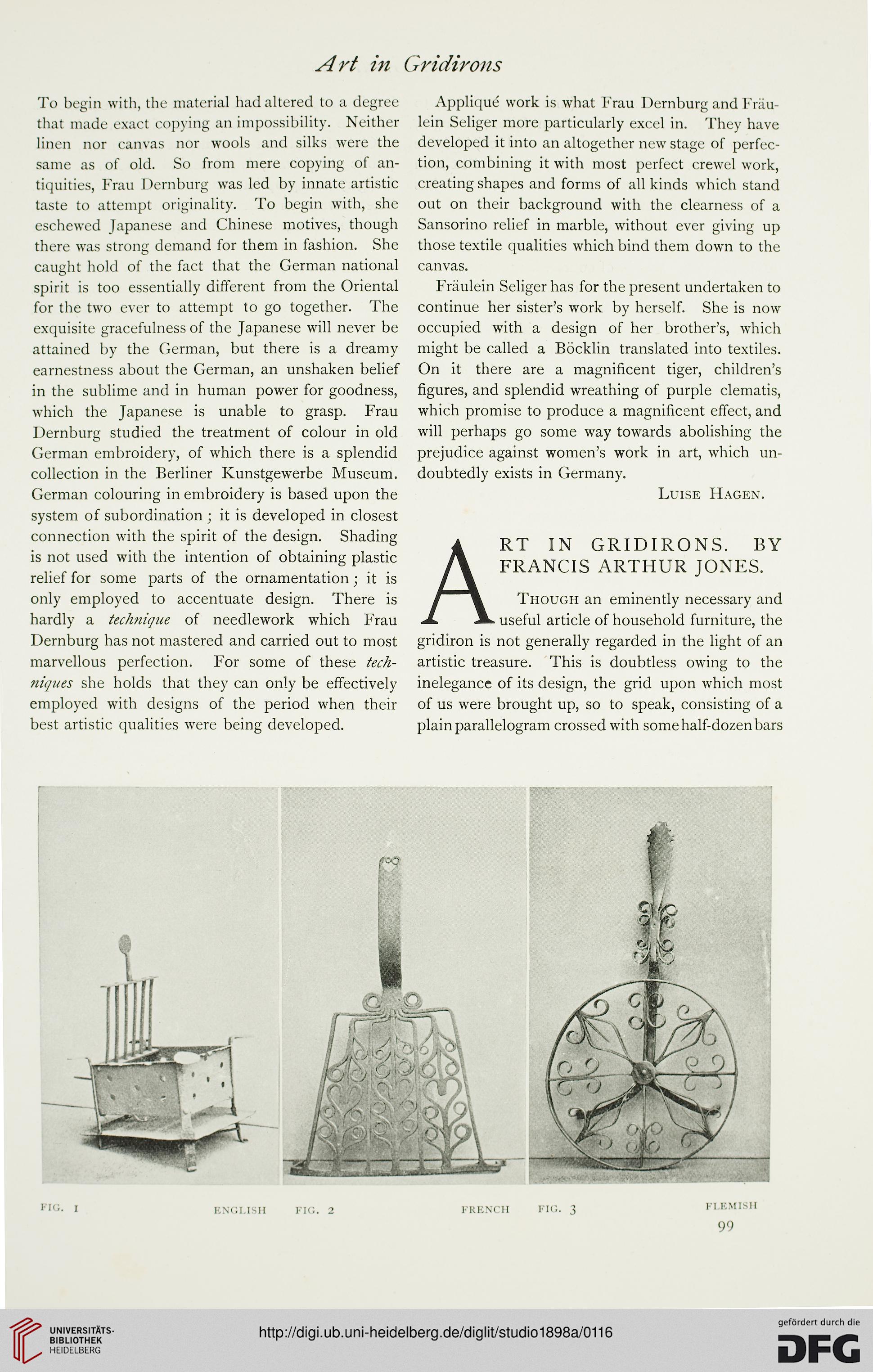Art in Gridirons
To begin with, the material had altered to a degree
that made exact copying an impossibility. Neither
linen nor canvas nor wools and silks were the
same as of old. So from mere copying of an-
tiquities, Frau Dernburg was led by innate artistic
taste to attempt originality. To begin with, she
eschewed Japanese and Chinese motives, though
there was strong demand for them in fashion. She
caught hold of the fact that the German national
spirit is too essentially different from the Oriental
for the two ever to attempt to go together. The
exquisite gracefulness of the Japanese will never be
attained by the German, but there is a dreamy
earnestness about the German, an unshaken belief
in the sublime and in human power for goodness,
which the Japanese is unable to grasp. Frau
Dernburg studied the treatment of colour in old
German embroidery, of which there is a splendid
collection in the Berliner Kunstgewerbe Museum.
German colouring in embroidery is based upon the
system of subordination ; it is developed in closest
connection with the spirit of the design. Shading
is not used with the intention of obtaining plastic
relief for some parts of the ornamentation; it is
only employed to accentuate design. There is
hardly a technique of needlework which Frau
Dernburg has not mastered and carried out to most
marvellous perfection. For some of these tech-
niques she holds that they can only be effectively
employed with designs of the period when their
best artistic qualities were being developed.
Applique* work is what Frau Dernburg and Frau-
lein Seliger more particularly excel in. They have
developed it into an altogether new stage of perfec-
tion, combining it with most perfect crewel work,
creating shapes and forms of all kinds which stand
out on their background with the clearness of a
Sansorino relief in marble, without ever giving up
those textile qualities which bind them down to the
canvas.
Fraulein Seliger has for the present undertaken to
continue her sister's work by herself. She is now
occupied with a design of her brother's, which
might be called a Bocklin translated into textiles.
On it there are a magnificent tiger, children's
figures, and splendid wreathing of purple clematis,
which promise to produce a magnificent effect, and
will perhaps go some way towards abolishing the
prejudice against women's work in art, which un-
doubtedly exists in Germany.
Luise Hagen.
RT IN GRIDIRONS. BY
FRANCIS ARTHUR JONES.
Though an eminently necessary and
useful article of household furniture, the
gridiron is not generally regarded in the light of an
artistic treasure. This is doubtless owing to the
inelegance of its design, the grid upon which most
of us were brought up, so to speak, consisting of a
plain parallelogram crossed with some half-dozen bars
To begin with, the material had altered to a degree
that made exact copying an impossibility. Neither
linen nor canvas nor wools and silks were the
same as of old. So from mere copying of an-
tiquities, Frau Dernburg was led by innate artistic
taste to attempt originality. To begin with, she
eschewed Japanese and Chinese motives, though
there was strong demand for them in fashion. She
caught hold of the fact that the German national
spirit is too essentially different from the Oriental
for the two ever to attempt to go together. The
exquisite gracefulness of the Japanese will never be
attained by the German, but there is a dreamy
earnestness about the German, an unshaken belief
in the sublime and in human power for goodness,
which the Japanese is unable to grasp. Frau
Dernburg studied the treatment of colour in old
German embroidery, of which there is a splendid
collection in the Berliner Kunstgewerbe Museum.
German colouring in embroidery is based upon the
system of subordination ; it is developed in closest
connection with the spirit of the design. Shading
is not used with the intention of obtaining plastic
relief for some parts of the ornamentation; it is
only employed to accentuate design. There is
hardly a technique of needlework which Frau
Dernburg has not mastered and carried out to most
marvellous perfection. For some of these tech-
niques she holds that they can only be effectively
employed with designs of the period when their
best artistic qualities were being developed.
Applique* work is what Frau Dernburg and Frau-
lein Seliger more particularly excel in. They have
developed it into an altogether new stage of perfec-
tion, combining it with most perfect crewel work,
creating shapes and forms of all kinds which stand
out on their background with the clearness of a
Sansorino relief in marble, without ever giving up
those textile qualities which bind them down to the
canvas.
Fraulein Seliger has for the present undertaken to
continue her sister's work by herself. She is now
occupied with a design of her brother's, which
might be called a Bocklin translated into textiles.
On it there are a magnificent tiger, children's
figures, and splendid wreathing of purple clematis,
which promise to produce a magnificent effect, and
will perhaps go some way towards abolishing the
prejudice against women's work in art, which un-
doubtedly exists in Germany.
Luise Hagen.
RT IN GRIDIRONS. BY
FRANCIS ARTHUR JONES.
Though an eminently necessary and
useful article of household furniture, the
gridiron is not generally regarded in the light of an
artistic treasure. This is doubtless owing to the
inelegance of its design, the grid upon which most
of us were brought up, so to speak, consisting of a
plain parallelogram crossed with some half-dozen bars





